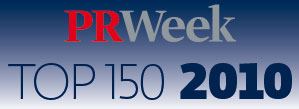 PR Week published its 2010 league table of the Top 150 PR agencies in the UK last week. The main headline was that overall the agency market was estimated to have grown by 0.75 per cent during 2009.
PR Week published its 2010 league table of the Top 150 PR agencies in the UK last week. The main headline was that overall the agency market was estimated to have grown by 0.75 per cent during 2009.
As comforting as this figure might be to all of us working in, or with, the PR industry my own take on the figures suggests that the picture may not have been quite so rosy. I estimate that a reduction of around 5-10 per cent is probably a more realistic range and is more consistent with David Brain’s analysis yesterday from a global perspective.
This conclusion is based on an analysis of the changing make up of the table and other supporting evidence.
For clarity PR Week’s 2010 league table is based on income generated in calendar year 2009. Similarly the 2009 league table is based on income generated in calendar year 2008.
Analysis of the league table positions
The table below shows the income that an agency had to achieve in each of the last two years in order to be ranked at the particular positions shown in the league table;
|
Position |
2008 income £’m |
2009 income £’m |
Change |
|
10th |
18.92 |
16.49 |
-12.8% |
|
25th |
8.35 |
7.52 |
-9.9% |
|
50th |
4.79 |
4.10 |
-14.4% |
|
75th |
2.87 |
2.64 |
-8.0% |
|
100th |
1.80 |
1.63 |
-9.4% |
|
150th |
1.14 |
0.44 |
-61.4% |
The table shows that to achieve a particular position in 2010 requires significantly less income at all levels compared to the 2009 league table. For instance to be ranked 25th in the table this year required an income of £7.52m, but to achieve the same position last year require £8.35m, a 9.9 per cent reduction.
Excluding the change at the 150th position the reductions are between 8.0 and 14.4 per cent with an average of 10.9 per cent.
In producing this table I have made adjustments for new entrants and mergers to make it more accurate:
2010 New entrants
Of the agencies that were new entrants into the Top 150 this year six of them would have been included in last years list had they submitted their figures. I have added these into 2009’s list for consistency.
Mergers
The numbers are also affected by the mergers of Grayling/Trimedia, Ketchum/Pleon and Tonic/Huntsworth Health. In these cases I have also combined the income for the three combinations in 2009’s list as well in order to compare like with like.
Other evidence that doesn’t fit with the headline estimate
Agencies joining and leaving the list – is it a fully representative sample?
It would appear that Stephen Waddington’s challenge to the industry to submit their numbers for the benefit of all has gone unanswered by some. 30 agencies (excluding those that have merged) that were in the top 150 last year do not appear in the 2010 league table.
Between them these agencies had total income in 2008 of £67.2m and varied in size between £13.80m and £1.13m. Given that the 150th position agency in the 2010 league table has income of £0.44m these agencies would have needed to have suffered a reduction in income of between 61 per cent and 97 per cent to have not made the cut.
This seems highly unlikely and what I suspect is more likely is that these agencies just didn’t submit figures this year. Obviously individual agencies could have any number of reasons why they chose not to, or were unable to, submit figures. However the absence of 20 per cent of last year’s list begs the question as to whether relying on just those who have submitted represents a valid sample. Have some agencies chosen not to submit numbers for fear of how they might look? Is the table therefore more likely to be biased towards those that performed better?
It is impossible to calculate a sensible estimate of the impact of these absences, but it does seem reasonable to question whether the sample, that the 0.75 per cent growth figure was based on, is truly representative.
Performance of the major Marcoms groups PR brands
The major global Marcoms groups that publish figures for PR specifically performed as follows in 2009:
|
Like for Like change in income |
|
| WPP |
-7.4% |
| Interpublic |
-4.5% |
| Omnicom |
-10.6% |
WPP is organic change from 2009 analyst report
Interpublic from PR Week article 17 March 2010
Omnicom is organic change from 2009 analyst report
It is obviously possible that the UK elements of these businesses performed better than the rest of the world. However given that the UK recession was amongst the longest and deepest and in the absence of any specific data to the contrary, I would take these figures as they stand.
Between them these three groups account for approximately £2bn in PR revenues worldwide and these figures would also indicate a reduction of approximately 5-10 per cent.
Conclusion
It was clearly going to be a challenge for PR Week to pull together a robust analysis this year due to the optional submission nature of the list. However I think there is significant evidence to suggest that the headline performance of slight growth is more than a little misleading.
But what do agency heads think? Is my estimate of minus 5-10 per cent nearer the mark?